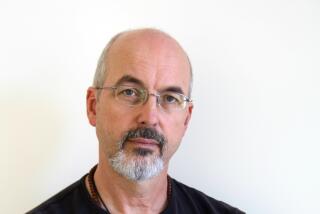Breaking the sound barrier
- Share via
CINEMA made a noisy leap forward on Aug. 6, 1926.
At the Warner Theater in New York City, Warner Bros. premiered the John Barrymore swashbuckler “Don Juan,” a showcase for Vitaphone, one of the early attempts to synchronize sound with film. “Don Juan” had no dialogue, just a synchronized musical score and sound effects, but audiences who paid a whopping $10 to see the film and a collection of short subjects -- violin virtuoso Efrem Zimbalist was one -- were mesmerized.
Vitaphone linked a movie camera to a turntable to record sound on a disk, then allowed a projectionist to play back the film and the disk in the theater. Several companies were working on sound-on-film systems, but Vitaphone, developed by Western Electric and Bell Telephone Laboratories, had a vastly superior sound compared with other sound-on-film systems. And for a moment, though the technology was cumbersome, it was enthusiastically embraced.
The Academy of Motion Picture Arts and Sciences’ Science and Technology Council will celebrate the 80th birthday of the Vitaphone with two screenings and an exhibition of Vitaphone equipment.
The birthday tribute begins Tuesday at the Linwood Dunn Theater with a re-creation of Vitaphone Corp.’s complete sound-on-disk program from 1926. Bob Gitt, preservationist from the UCLA Film and Television Archive -- one of the major restorers of the Vitaphone films -- hosts the evening.
The following Tuesday, a second evening of restored sound-on-disk films will be screened at the Dunn, including Edgar Bergen in 1930’s “The Office Scandals,” Spencer Tracy in 1929’s “The Hard Guy,” George Burns and Gracie Allen in 1929’s “Lambchops” and Baby Rose Marie in 1929’s “The Child Wonder.”
The exhibition of Vitaphone rarities will be on display in the foyer of the theater through Dec. 3 and can be viewed whenever the academy presents programming at the Dunn.
Also, UCLA’s film preservation festival is throwing a birthday party for Vitaphone this Thursday, with an evening of recently restored Vitaphone short subjects from 1927 to 1930 and the 1928 Vitaphone feature “The Barker” at the James Bridges Theater.
But Vitaphone wasn’t the first attempt to bring sound to film.
“There was probably 30 years’ work in synchronized sound,” says council head Andy Maltz. From 1910 to 1914, for example, Eugene A. Lauste made sound for films. In 1913, Thomas Edison developed the Kinetophone, which connected a special cylinder-shaped machine to a film projector by an overhead belt with 3-inch-long pulleys. The projection booth even had a braking device to slow the film speed to keep it in sync.
Warner Bros. liked the Vitaphone technology because it was so far superior to such experiments and, not incidentally, because the sound disks could play for about 10 minutes, the length of a film shot on a 1,000-foot reel.
After the success of “Don Juan,” Warner Bros. was signing up exhibitors left and right even if the theaters couldn’t afford to install Vitaphone equipment.
“Western Electric thought it would be, like, $5,000 a theater in 1926, but it ended up being $16,000 to $25,000 per theater,” says Maltz.
“Warner Bros. basically became a finance company. They financed about $2.5 million in Vitaphone installments.”
Though the other studios were using sound-on-film technology by 1929, Warner Bros. had invested so much in the Vitaphone system that it continued to make sound-on-disk films through 1930, switching to sound-on-film in 1931.
UCLA has restored some 65 of the Vitaphone films in conjunction with the Library of Congress “because they have the pictures in most cases, and we have the disks,” says UCLA’s Gitt.
Gitt says the restoration process can be arduous. “In some cases there is only one disk surviving because the rest got thrown away. We acquired, like, 2,500 disks from the Warner Bros. sound department in the late 1980s, and we can play them on a synchronized turntable which turns at exactly 33 1/3 rpm. When we transfer the sound onto a modern soundtrack, it pretty much automatically lines up with the picture.”
But when private collectors own the disks, they often offer preservationists only digital or audiotape copies, and these, says Gitt, do not synchronize with the film. “We literally have to go into the computer and test it and get it to run to the exact speed,” he says.
Occasionally, the disks have survived but the film has been lost, as in “some wonderful-sounding things like Jack Benny in ‘Bright Moments’ from 1927,” says Gitt. And in other cases, only soundless performances remain.
As for why the technology itself didn’t last more than a few years, Gitt says that it posed numerous problems -- not the least of which was synchronization.
“Because of the heavy arm on the Vitaphone playback turntable, the disks wore out very quickly,” he says. “They could play a disk only 20 times. When a film would run more than a week, they had to send multiple disks. Sometimes the needle would get stuck in the groove” -- destroying any chance of the sound matching the action. “And they had to change the needle every 10 minutes.”
*
80th Anniversary Salute to Vitaphone
Where: Linwood Dunn Theater, 1313 N. Vine St., Hollywood
When: 7:30 p.m. Tuesday, 7:30 p.m. Aug. 1
Price: $3 to $5
Contact: (310) 247-3600 or www.oscars.org
Also
What: Vitaphone Varieties 1927-1930
Where: James Bridges Theater, UCLA
When: 7:30 p.m. Thursday
Price: $5 to $8
Contact: (310) 206-FILM or www.cinema.ucla.edu
More to Read
The biggest entertainment stories
Get our big stories about Hollywood, film, television, music, arts, culture and more right in your inbox as soon as they publish.
You may occasionally receive promotional content from the Los Angeles Times.











